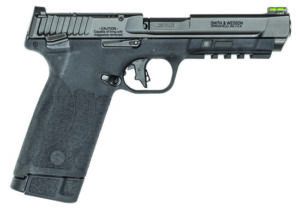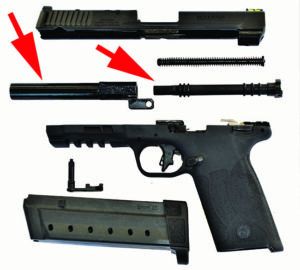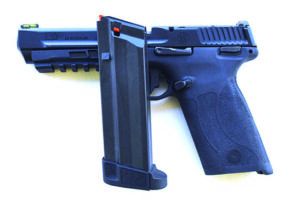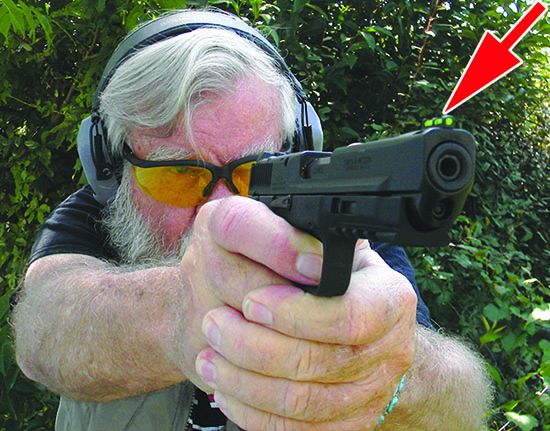The 5.7x28mm cartridge, also called the FN 5.7x28mm or the FN 5.7x28mm NATO, seems more popular than ever, largely due to the introduction of modern handguns such as the FN FiveSeveN and Ruger-5.7. We’ve been interested in the round for a while, reviewing the FiveSeveN in the November 2011 issue (versus the 22 Magnum KelTec PMR-30) and the December 2014 issue (versus the Rock Island Armory Micro Mag Standard 51687 22 TCM) and the Ruger-5.7 in the October 2020 issue (versus the Rock Island Armory TCM044816 22 TCM and the KelTec PMR-30 PMR30BBLK 22 WMR). We also covered the FN PS90 chambered in the round (January 2018) and the 57Center AR57 PDW 5.7x28mm Upper in the March 2011 issue. It seems 5.7x28mm firearms are more affordable and more useful than ever before.
Still, an issue for training with the 5.7x28mm cartridge has been the high cost of ammunition. Fiocchi has made an effort to bring the price of 5.7 down, with 150 rounds of 5.7x28mm currently running about $79 versus as much as $45 per 50-round box not long ago. A box a month in practice is becoming attainable. With this in mind, we matched the Smith & Wesson M&P 5.7 Series 13348 5.7x28mm, $579, against the new Smith & Wesson M&P 22 Magnum Series 13433 22 Magnum, a $599 pistol. The result was one of the more interesting shoot-outs and a lot of ammunition fired in these addictive handguns.
How We Tested
Because some shooters will wish to deploy the pistols for personal defense as well as informal shooting, we tested a number of loads in water jugs, our standard testing material. First up was the 5.7x28mm Fiocchi Hyperformance 40-grain polymer-tipped hollow-point round (57PT40). At 1730 fps, this load penetrated an average of 15.0 inches of water. Expansion averaged 0.455 inch, although there was also some fragmentation. Next up came the Vanguard Outfitters Black Fang loading. This is a wickedly-pointed solid-copper bullet intended to tumble, but not expand or fragment. At 1890 fps, it did tumble, exiting the side of the water jug on all three tries. The Speer Gold Dot bullet at 1835 fps penetrated 18 inches and expanded to 0.302 caliber. This is consistently good penetration that seems to track straight. We also fired an FN-branded load, the SS197SR with a 40-grain V-Max tipped hollow point, the same design as the Fiocchi. We didn’t shoot it in water, but we’d expect the FN load to fragment like the Fiocchi round, with 79 fps more velocity and 22 foot-pounds more energy. A Fiocchi Range Dynamics subsonic FMJ round (57SUB62) with a 62-grain payload wouldn’t operate the S&W pistol consistently, so we didn’t gather data on it.
In the 22 Winchester Magnum Rimfire (WMR) rounds, we tested the CCI Maxi-Mag 30-grain TNT jacketed hollow points (0036). This load broke up in 7 inches of water, exactly as designed. Such performance makes for a potent pest popper. The CCI Maxi-Mag at 1382 fps penetrated 18 inches but did not expand. The Hornady 45-grain Critical Defense ammunition clocked a consistent 1254 fps. Penetration was 14 inches, with consistent expansion to 0.34 caliber. When all is said and done, the 22 Magnum and 5.7x28mm are separated by the 5.7’s energy release into the second water jug with tremendous disruption. For self defense, we would prefer the 9mm Luger to either, based on our extensive testing and practical experience. But the 22 Magnum and 5.7x28mm are each starchy plinkers, with ranges much greater than the 22 LR. However, are these Smith & Wesson platforms good launching pads for these rounds? We think so, as the details below explain.
Smith & Wesson M&P 22 Magnum Series 13433 22 Magnum
$599
Gun Tests grade: B
With its easy-to-rack slide, low recoil, and surprising accuracy, the newest Military & Police handgun is a winner in the easy shooting category. A generous magazine capacity makes this handgun a fun plinker. We cannot recommend any 22 Magnum for personal defense, and we rated the pistol down a grade on reliability.

| Action Type | Internal hammer-fired, gas-operated, locked-breech Tempo barrel system |
| Overall Length | 8.4 in. |
| Overall Height | 5.9 in. |
| Maximum Width | 1.15 in. |
| Weight Unloaded | 22.0 oz. |
| Weight Loaded | 26.0 oz. |
| Barrel 4.35 in. long, stainless steel, | 4.35 in. long, stainless steel, 1:10 twist |
| Slide | Black finish, RMSc optics cut, ambi slide stop, front serrations |
| Slide Retraction Effort | 11.9 lbs. |
| Frame | Full-size black polymer, Picatinny rail |
| Frame Front Strap Height | 3.75 in. |
| Frame Rear Strap Height | 4.1 in. |
| Frame Grip Thickness | 1.1 in. |
| Frame Grip Circumference | 5.6 in. |
| Magazines | (2) 30 round |
| Rear Sight | Drift adjustable black notch |
| Front Sight | Green Fiber-optic tube |
| Sight Radius | 6.5 in. |
| Trigger Pull Weight | 4.5 lbs. |
| Trigger Span | 2.75 in., flat-face style |
| Safety | Manual lever, left side |
| Warranty | Lifetime Service Policy |
| Telephone | (800) 331-0852 |
| Website | Smith-Wesson.com |
The newest rimfire from Smith & Wesson is an interesting pistol and one that we enjoyed firing a great deal. A polymer-frame hammer-fired type, the 22 WMR pistol features a 30-round magazine, much like the PMR-30 from KelTec. That is a lot of plinking fun.
This handgun is an interesting combination of style and utility. While the appearance and measurements are fully in the service-handgun size, the pistol is light and portable. The 22 Magnum is a favorite of backpackers and outdoors folks, and this is a good piece of equipment for many in that category. We don’t think the 22 Magnum is suitable for personal defense based on its terminal ballistics, but then the cartridge has good penetration and it is easy to control, so its ability to put rounds on a threat isn’t something to sneeze at. For small game such as rabbits and squirrels and dusting off venomous snakes, the 22 Magnum is a great choice. The cartridge is light for feral dogs, but it’s maybe right for bobcats.

The primary benefit of owning the M&P 22 Magnum is recreational. While we limited accuracy testing to the usual three types of cartridges, we fired a good mix of bullet weights in the pistol, ranging from 30 to 45 grains. It proved interesting that the pistol’s 4.35-inch barrel generated as much or more velocity than a 6.5-inch-barrel Ruger Single Six revolver in 22 Magnum we had on hand. With the pistol, there’s no barrel-to-cylinder gap, you know.
Nothing in the pistol’s appearance seems ground-breaking. There is a certain family resemblance to other Military & Police firearms. The fairly slim slide is a tip off this is a rimfire handgun. The slide features a black Armornite coating. The frame is black polymer with an accessory rail for mounting combat lights or lasers. One of the raters mentioned that predator or pest shooting at night (where legal) would be more efficient in some instances with a mounted light or laser. The grip seems larger than most mid-sized pistols, but without any recoil to speak of, the girth was not a drawback. A relief cut near the trigger guard and comfortable beavertail tang made for excellent gripping. The balance of adhesion and abrasion are good. One of our raters is a 63-year-old female with a touch of arthritis. She completely enjoyed firing the 22 Magnum autoloader.
Trigger-pull weight is a nice 4.5 pounds. While the pistol is a single-action hammer-fired handgun with an ambidextrous manual safety, a further safety measure is found in a lever set in the trigger. When you consider that this lever will help prevent lateral-pressure discharge but doesn’t slow getting the pistol into action at all, it is nice to have this feature. The ambidextrous safety falls under the thumbs of either hand easily, making the pistol pretty friendly to lefties. The slide lock is also present on both sides of the frame. The pistol’s magazine release may be operated by the left-hand forefinger. So, if you are looking for a left-hand friendly handgun, this pistol is a good place to start.
Everything said about the Military & Police 22 Magnum in that regard also applies to the 5.7 version. If a left-hand shooter doesn’t wish to use the forefinger to manipulate the magazine release, simply rotate the screw head of the catch 90 degrees, remove, and replace on the opposite side.

All controls operate as designed. The safety is ideal, requiring some effort to place on Safe, but moving to the Fire position easily, without the shooter having to shift the firing grip. Takedown is not quite as simple as a Glock or SIG, but is simple enough. A pin must be removed with a punch to disassemble the M&P 22 Magnum. The slide, frame, barrel, barrel shroud, and recoil spring assembly are easily separated and laid out for cleaning.
The sights are well suited to the role of the M&P 22 Magnum and were universally praised. A bright fiber-optic insert in the front sight affords good visibility. The rear sight features a generous notch and is adjustable for windage. Two 5⁄64-inch Allen screws hold a top plate in place for mounting optics. We did not explore this option, but it’s there.
We expanded the breadth of testing over our usual program. We fired several loads offhand and fired the usual three loads for accuracy (in the Range Data sidebar), varying the bullet weights. Also, we performed limited function testing to compare the 22 Magnum to the 5.7x28mm pistol. The loads fired included the Winchester 25-grain NTX, CCI 30-grain TNT, Hornady 30-grain V-Max, Armscor 40 grain, CCI Maxi-Mag 40 grain, Federal 45-grain Punch, and Hornady 45-grain Critical Defense.
Before firing, we lightly lubricated the barrel hood and slide rails. For accuracy testing, we fired the CCI 30-grain TNT, CCI Maxi-Mag 40, and Hornady 45-grain FTX. We fired 400 cartridges and added about 35 from a leftover bag donated by one of the raters. All of the raters noted that the pistol looks like a striker-fired mechanism, but the subtle difference in a single-action hammer-fired trigger was evident. We liked the trigger action and felt it makes the most sense in this design envelope. Most, but not all, 22 rimfire Magnum pistols use a simple blowback design. The Smith & Wesson, in common with other 22 Magnum pistols we have tested, is a type of delayed blowback, but the S&W differs in using a gas action known as the Tempo to operate the pistol. It is a gas action, but with gas vents inside the barrel shroud. You don’t need a heavy slide mass for this system, and it avoids the unnecessarily bulky slide of the Walther 22 Magnum (April 2023) previously tested. The system seems clean burning. We did not clean the pistol for the entire test period. Because the most reliable loads were fired at both the beginning and end of the test, powder ash was not a factor. We found ammunition bullet weight was tied to both accuracy and reliability.
Loading the 30-round magazines demands care. Be certain to load the cartridges so that the cartridge rim of the following cartridge is in front, not behind, the previous cartridge. We loaded three rounds, tapped the rear of the magazine, and continued to load. Loading up to 28 rounds is easy, but the last two demand more effort. For most of the test, because we used 50-round boxes of ammunition, we loaded 25 cartridges at a time.
We used one 25-grain, two 30-grain, two 40-grain, and two 45-grain bullet loads. Firing off hand at small targets beginning at 7 yards, we progressed to 10, 15, and 25 yards in offhand fire. Only the need to save enough ammunition for firing the 25-yard group kept the team from firing every cartridge in the range box. This pistol is fun to fire and use. We rated the pistol for pest popping and found that it is capable of striking small animal targets to at least 25 yards. It also strikes the steel gongs much harder than a 22 Long Rifle, with a louder reverberation returning to the raters. Also, 8-inch gongs at 50 yards were not a problem, although feedback did not always indicate a hit. We might hit the gong, but it wouldn’t move.
A fly in the ointment was reliability. With the 25- and 30-grain loads, we usually suffered four to seven short cycles in each magazine, unacceptable, especially if you are considering a defensive role for this handgun. The 45-grain Hornady FTX, despite its lower velocity, went through two magazines without failure. This load was developed with short-barrel pistols in mind. The Federal 45-grain Punch suffered two to three odd short cycles per magazine. A cartridge ejected and the next round failed to feed, and the slide went home on an empty chamber. The CCI Maxi-Mag 40-grain load is often touted as the most reliable of loads in 22 Magnum self-loading pistols. It earned that spot again in this test with 100 trouble-free rounds, 50 at the beginning of the test and 50 at the end.
We saved enough 30-grain ammunition to run at the end to ensure that the original malfunctions were not break-in malfunctions. They were not; poor function followed. The Armscor loading also ran well, without a single malfunction. So, take care in load selection if you make the Smith & Wesson a front-line pistol. Because popping pests and rodents isn’t a particularly dangerous pursuit, an occasional misfeed isn’t serious. It’s just not welcome.
Most of the loads ran as expected for velocity. The 30-grain loads were clocking a fast 1500 fps, excellent for the rimfire 22 Magnum. For accuracy testing, we fired from a solid benchrest at 25 yards. The sights were held dead on the big red bullseye for best accuracy and a dead-on hold. The 30-grain groups were disappointing at 2.4 to 2.8 inches for a five-shot group. We could not get a 2.0-inch group with the 40-grain load, but came very close. The most accurate load was the Hornady Critical Defense 45-grain FTX with a single 1.8-inch group, but a 2.25-inch average.
Our Team Said: The pistol is accurate enough for most chores. We like the Smith & Wesson Military & Police 22 Magnum, but we rated it down a full grade on reliability issues. While you may experiment with your own gun and load combination, we feel the pistol is predictably reliable with 40-grain loads. Also, S&W says on its website that jacketed bullets must be used the handgun, and that copper-coated or polymer-coated bullets “will cause reliability issues.” The company has a list of 17 brands and bullet weights that are said to run well in the pistol.
| 22 WMR (22 MAGNUM) RANGE DATA | |
| CCI Maxi-Mag TNT 30-grain TNT JHP 0036 | S&W M&P 22 Magnum |
| Average Velocity | 1503 fps |
| Muzzle Energy | 150 ft.-lbs. |
| Smallest Group | 2.4 in. |
| Average Group | 2.6 in. |
| CCI Maxi-Mag 40-grain JHP 0024 | S&W M&P 22 Magnum |
| Average Velocity | 1382 fps |
| Muzzle Energy | 170 ft.-lbs. |
| Smallest Group | 2.3 in. |
| Average Group | 2.5 in. |
| Hornady Critical Defense 45-grain FTX Polymer Tip HP 83200 | S&W M&P 22 Magnum |
| Average Velocity | 1254 fps |
| Muzzle Energy | 157 ft.-lbs. |
| Smallest Group | 1.85 in. |
| Average Group | 2.25 in. |
Written and photographed by Gun Tests Staff, using evaluations from Gun Tests Team members. GT



























